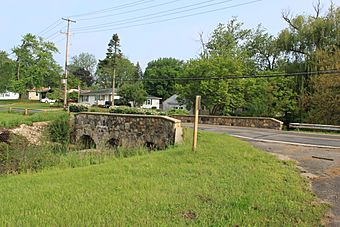Mill Street–South Branch Raisin River Bridge facts for kids
Quick facts for kids |
|
|
Mill Street–South Branch Raisin River Bridge
|
|
 |
|
| Location | Mill Street over South Branch River Raisin, Brooklyn, Michigan |
|---|---|
| Area | Less than one acre |
| Built | 1925 |
| Architect | Michigan State Highway Department |
| Architectural style | Concrete arch |
| MPS | Highway Bridges of Michigan MPS |
| NRHP reference No. | 99001675 |
| Added to NRHP | January 14, 2000 |
The Mill Street–South Branch Raisin River Bridge is a special bridge in Brooklyn, Michigan. It carries Mill Street right over the South Branch of the River Raisin. This bridge is so important that it was added to the National Register of Historic Places in the year 2000. This means it's a historic landmark worth protecting!
Contents
Why Was This Bridge Built?
A Look Back at the Old Bridge
Before the current bridge, there was an older one in the early 1900s. That bridge was made of stone arches and had three sections. It helped people cross the river for many years.
Henry Ford's Big Idea in Brooklyn
In 1921, the famous car maker Henry Ford bought a water-powered mill nearby. This mill was part of his "village industries" plan. Ford wanted to build small factories in rural areas. This would create jobs and use local resources.
Building a New Bridge for More Traffic
The Mill Street Bridge was built in 1925. It was likely constructed because of Henry Ford's mill. People expected a lot more cars and trucks to use the road. The new bridge was designed to handle all that extra traffic. It's even thought that some of the stone on the new bridge came from the older one!
The Mill's Purpose Over Time
Even though the bridge was ready, the mill site stayed empty for a few years. Finally, in 1937, the mill started making car parts. It produced things like automobile horns, distributors, and starter switches.
What Does the Bridge Look Like?
Size and Main Features
The Mill Street Bridge is a concrete arch bridge. It is about 35-foot-long (11 m). The part of the bridge where cars drive, called the deck, is about 22.4-foot-wide (6.8 m). The bridge has three arches, and the biggest one is about eight feet (2.4 m).
Stone Details and River Features
The bridge has special concrete walls that flare out, called wingwalls. These are covered with a cool stone look. On the side of the bridge where the river flows in (the upstream side), there are pointed parts called cutwaters. These help the water flow smoothly around the bridge supports.
On the other side, where the river flows out (the downstream side), there's a concrete slope that goes down to the riverbed. The railings along the sides of the bridge are also solid and covered with stone. Even the riverbanks on both sides of the bridge are lined with stone. It all makes the bridge look very strong and natural.

